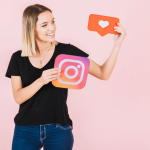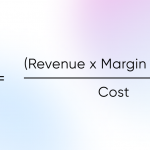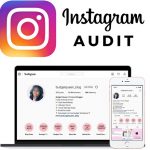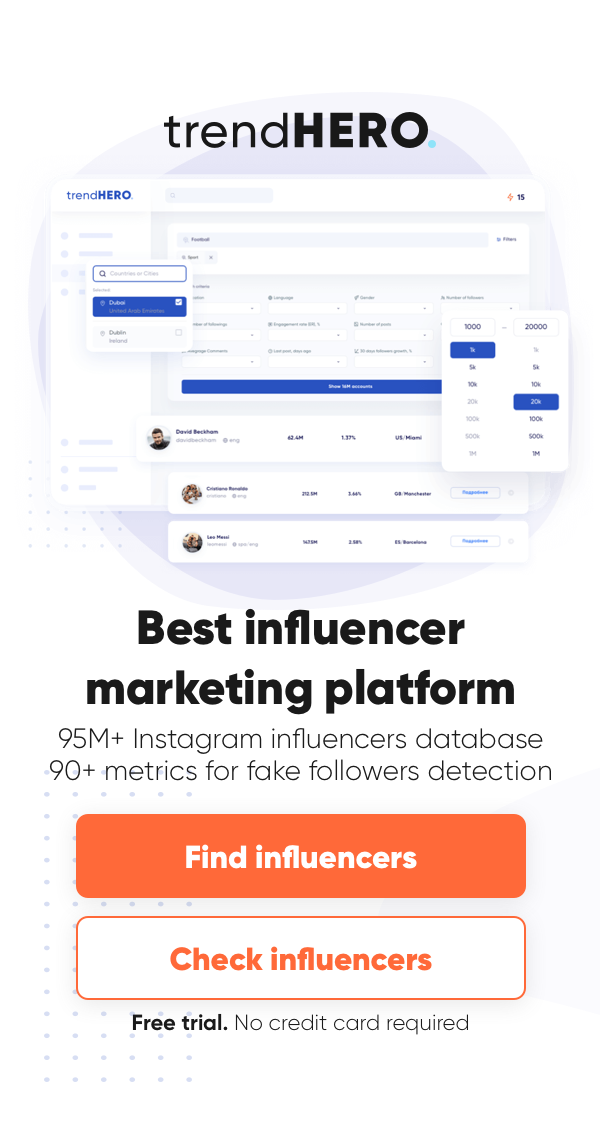- Home
- BLOG
- Instagram Marketing
- A Detailed Guide to Understanding Influencer Marketing Automation
Businesses have been using automation to streamline work processes, increase productivity, accelerate sales, and improve ROI. By automating repetitive tasks, marketers can focus on strategic tasks like research, goal setting, and analysis.
Influencer marketing isn’t just here to stay; it’s growing. Statistics show the industry’s market size at $16.4 billion in 2022, with a projected growth of $4.62 billion in 2023. As businesses earmark more of their budgets for influencer strategies, marketers need automation to manage influencer recruitment, track workflows, monitor performance, and more.
This guide will help you understand how automation enables you to scale influencer marketing efforts effectively.
What is influencer marketing automation?
Simply put, influencer marketing automation is the use of software to streamline influencer marketing processes. Say you want to check whether your brand influencer’s follower count is genuine. You could scroll through their following for egg/empty accounts. Or, you could use a social media auditing tool that shows you what percentage of an influencer’s audience are real followers.
Other ways you can apply automation include
- Identifying suitable influencers
- Influencer outreach
- Content workflows
- Campaign performance monitoring
- Reporting and analysis
Launching an influencer marketing campaign takes time and effort. Automation accelerates these processes, saving you time and money.
3 advantages of automation in influencer marketing
Influencer marketing automation offers the following benefits.
Identifying the right influencers
According to data from Earthweb, there are between 3.2 to 37.8 million influencers on Instagram, YouTube, and TikTok. That’s a lot of content creators to sift through to find the ones that match your target audience, brand values, and marketing objectives.
You can search hashtags on social media websites to find relevant influencers in your niche industry. But that could take days. On the other hand, influencer discovery tools like trendHERO allow you to search for suitable influencer profiles and verify email addresses within minutes. These marketing automation platforms have vast databases with smart filters to help you select creators based on content, audience demographics, social media metrics, and more.

On trendHero, you can select potential influencers based on the number of followers, engagement rate, average comments, likes, keywords, etc.
Campaign management
Influencer marketing automation can help streamline your workflow and content management, allowing your marketing team to visualize your campaign’s progress. For example, content workflows define tasks to be completed, by whom, and when.
Below is an example of a content creation workflow on Trello.

It visually tracks the progression of tasks through five named stages.
Defining workflows keeps influencers and marketing teams accountable. It enables marketing managers to identify bottlenecks and take mitigative action. For example, you can use generative AI to create article outlines if you learn your team struggles with content ideation.
Performance tracking
Collecting data is vital for every business strategy. How else will you know if your influencer marketing program is successful without tracking performance metrics such as impressions, engagement, conversion rates, and ROI?
Chances are you’re running multiple influencer campaigns at a time. Rather than tracking each influencer, ad, or mention separately, you can use influencer analytics tools to see who drives the most traffic and where you should be focusing more time, money, and effort.
For instance, if your campaigns perform better on Instagram than on YouTube, you could engage more Instagram influencers.
You don’t even have to wait until the end of the project to know what’s working. Automated reports allow you to monitor performance in real-time, and you can spot potential issues and make timely changes.

The above influencer report highlights the performance of each post. You can view the number of views, comments, and likes for each post. You can also compare these with the account’s averages to gauge how well a particular post is doing.
3 drawbacks of automating influencer marketing
Some say there are drawbacks to adopting automation for influencer marketing campaigns. However, as we shall see later on, these can be easily addressed.
Issues related to duplication
Strict, cookie-cut content briefs for creators are convenient, especially when working with multiple influencers. However, the result can be identical ads, which can be counterproductive.
Lack of personalization
Strictly speaking, automation doesn’t allow you to tailor influencer briefs to creators on different platforms. Content on Instagram isn’t the same as on blogs or Twitch. Each social platform has unique cultures, features, formats, and audiences. For example, TikTok is great for starting viral trends, while unboxing videos do well on YouTube. Automation doesn’t account for these differences.
Another way automation hinders personalization is through communication. Automated messages save you time but don’t leave room for customization. No one likes feeling like a cog in a wheel. Personalization matters because it makes people, influencers included, feel valued and motivated to promote your brand.
Limited human connection
One of the drawbacks to automated influencer programs is the limited human connection, which underlies the two previous points. With automation, you can argue it’s a machine, not you, that reaches out to influencers. You can’t build organic, long-term relationships with influencers with a machine.
But even with these three drawbacks, the advantages of automation trump its disadvantages. Automation ensures productivity and accuracy.
Plus, the issues described above can be addressed with a bit of conscious effort.
For instance, to address issues related to duplication, you can create different automated briefs for different influencers. To address issues of personalization and human connection, you can create messages customized to each influencer and social platform. You can also build long-term relationships with influencers by personally commenting on or liking their posts even after or before your automated influencer marketing campaign.
How to automate your influencer marketing strategy
Now that you know automating your influencer marketing strategy is a must, let’s explore how exactly you can do that:
1. Define your objectives and target audience
The first step to automating any strategy is defining goals and target customers. Before you source, select, and engage with influencers, you should be clear on what you hope to achieve with your influencer marketing program. Do you want to gain more likes on Instagram? Are you looking to manage your brand reputation?
The chart below lists the top influencer marketing goals.

The number one reason marketers use influencer marketing is to reach new customers. Brand awareness and sales are second and third, respectively.
When you know what you want to achieve, you can set up appropriate measures for tracking campaign performance. For instance, if your goal is brand awareness, the metrics you should be monitoring with your influencer marketing platforms include brand mentions, direct traffic, and search volume.
In addition to defining your campaign objectives, you must understand whom you’re trying to influence. Knowing your customers will help you choose influencers that resonate with them. For example, if you’re targeting B2B and enterprise SaaS customers, your ideal influencers would be event speakers and thought leaders respected in their niche.
Buyer personas are detailed descriptions of your ideal customers. They outline their demographics, goals, frustrations, preferred social media platforms, and more. The goal is to understand the customer’s journey to meet their needs. The more details you include, the better.

This customer profile shows that the customer consumes blog content around parenting. You now know the most suitable influencers to recruit are bloggers, not YouTube or Instagram content creators.
2. Identify and vet influencers
Once you know your influencer program’s purpose and target audience, you have a clearer picture of the type of influencer to collaborate with. Earlier, we identified influencer databases as powerful tools for finding social media influencers. That’s a good start, but you must dive deeper. You need to consider the influencer’s reach, resonance, and relevance.
Reach refers to the number of people you access through an influencer’s follower base. If an influencer has 5,000 followers, that’s your reach. For goals like brand awareness, opting for influencers with large follower counts is a good idea. However, bigger isn’t always better. Influencers may have millions of followers, but you won’t meet your goals if they aren’t active.
That’s why you should also consider resonance. Resonance is the level of engagement influencers create around your brand. Here, micro and nano influencers are beneficial. These content creators have a small but highly engaged following. That is what you want – highly qualified leads.
For your strategy to be effective, you must work with relevant influencers. Look at what they are posting. Is their content relevant? Is their following made up of your target audience?
Finally, you must vet influencers. Influencer fraud costs businesses $1.3 billion annually. When fraudsters create fake accounts or buy fake followers, brands end up wasting money on potential customers that aren’t real.
So, how do you spot a fake influencer?
- Unaccountable spikes in their follower count
- Low engagement compared to the number of followers
- Irrelevant or identical comments
- Inactive or empty account profiles
- Stock photos
Fortunately, you don’t have to comb through potential influencers’ accounts. Most influencer marketing platforms, like trendHERO, come with vetting tools. Don’t forget to ask for a portfolio of their previous collaborations to determine quality and content alignment.
3. Develop an outreach and campaign strategy
Approaching influencers should be handled with care. The goal is connection and relationship-building. Many worthwhile influencers are protective of their brand and only work with brands that match their values. Formulaic sales pitches won’t work. You must build influencer relationships organically.
Start by following their blogs or liking/commenting on their posts. Engaging with their content allows you to determine what kind of collaboration will work best for your brand – whether it is an ambassadorship, giveaways, guest posting, etc. It also shows content creators you are genuinely interested because you have been interacting with them.
When you reach out, you can contact them privately through DM or email. If you’re sending messages to multiple influencers with influencer marketing platforms, make an effort to personalize each message. Share your vision for the potential partnership, including brand values, and show the benefit of the collaboration.
When done correctly, influencer outreach allies you with powerful brand advocates.
4. Integrate influencer marketing automation tools
I’ve already mentioned several instances when you can use automation tools to execute each of the steps above.
Setting up influencer marketing tools to automate each process is easy. With trendHERO, you just need to sign up for an account.
But your job doesn’t end there. Businesses sometimes fail to integrate their new marketing automation software with their existing tech stack, creating data silos. For example, if you don’t integrate influencer marketing tools into your CRM (customer relationship management) platform, you have an incomplete picture of the customer’s journey and history.
So, when you integrate your new influencer marketing platform, consider your overarching marketing processes. Also, be sure to get employee buy-in with onboarding and training sessions to familiarize workers with the tool.
In Closing
Automation improves many aspects of influencer marketing. As the industry grows and businesses increase their influencer marketing budgets, more marketers turn to automation to improve productivity and scale their marketing efforts.
Automating influencer recruitment, workflow management, and performance tracking frees marketers from tedious, time-consuming activities. It allows them to focus on other aspects of growing their business.
Why not use automation to your advantage in your influencer marketing campaigns? You’ll reap the best results.
Author’s Bio

Owen Baker is a content marketer for Voila Norbert, an online email verification tool. He has spent most of the last decade working online for a range of marketing companies. When he’s not busy writing, you can find him in the kitchen mastering new dishes.
We also recommend to read
 How to Check if Someone Bought Instagram Followers
How to Check if Someone Bought Instagram Followers  How Does Instagram Promotion Work
How Does Instagram Promotion Work  Creating a Social Media Marketing Strategy in 8 Easy Steps
Creating a Social Media Marketing Strategy in 8 Easy Steps  Influencer Marketing ROI: Measuring Success and Overcoming Challenges
Influencer Marketing ROI: Measuring Success and Overcoming Challenges  How to Find Micro-Influencers in 10 Steps
How to Find Micro-Influencers in 10 Steps  How to Run an Instagram Audit in 2023 (Free Audit Tools Inside!)
How to Run an Instagram Audit in 2023 (Free Audit Tools Inside!)Instagram Engagement Rate Calculator For Free
Check any influencer's Engagement rate and analyze his or her followers growth history
Other free tools: Follower Count History, Instagram Follower Count, CPM Calculator
